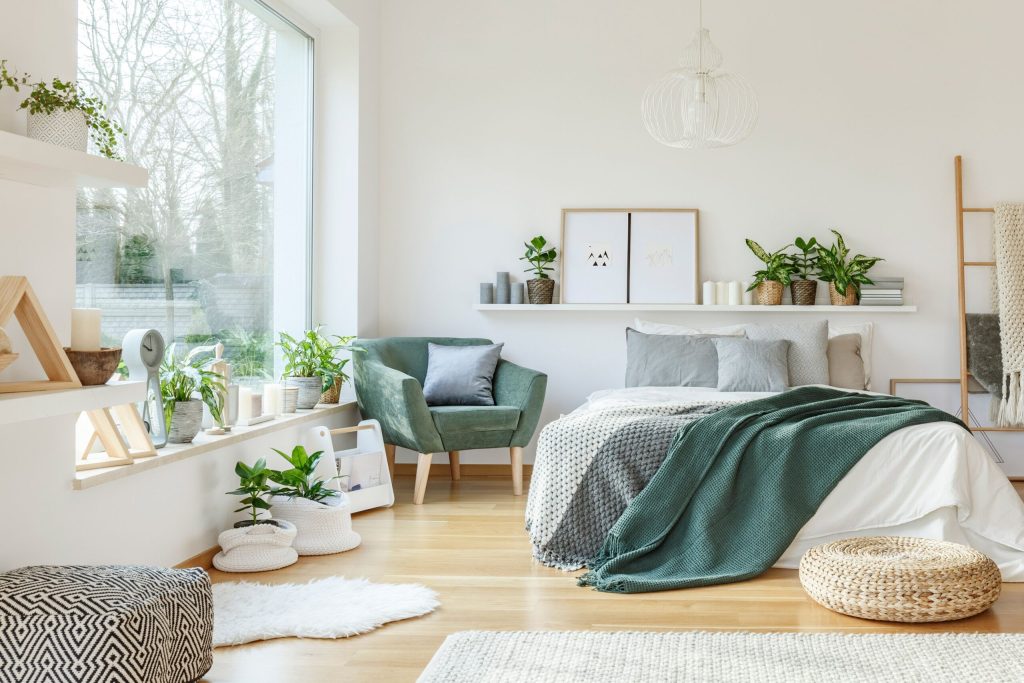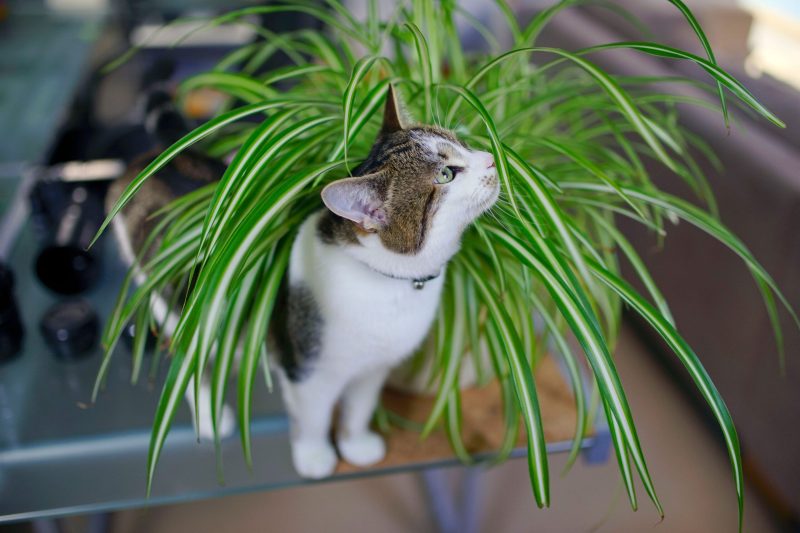Best Plants for Your Bedroom

Adding plants to your bedroom can create a peaceful space with better sleep and improved air quality. In this guide, we’ll explore the best plants for your bedroom, accounting for factors like maintenance, air-purifying abilities, and design. Whether you’re an experienced plant parent or just starting out, you’ll find a few options to suit your needs.
Factors for Choosing Bedroom Plants
Incorporating plants into your bedroom offers many benefits. When selecting plants for your bedroom, there are a few key factors you need to account for so your plants can grow in their new space. These will help you choose the best plants for your bedroom environment.
Light Requirements
The amount of natural light in your bedroom plays a big role in the plants you choose. Many bedrooms have limited light because of window coverings or construction orientation. If your room has low light conditions, choose plants that can grow in shade or indirect light. For rooms with more sunlight, you’ll have a wider range of options.
Maintenance Needs
Factor in how much time and effort you’re willing to dedicate to plant care. Some plants require frequent watering and pruning, while others are more self-sufficient. If you’re new to plant care or have a busy lifestyle, choose low-maintenance options that can tolerate occasional neglect without suffering damage.
Air Purification Abilities
Many plants are known for their air-purifying properties, which can be especially helpful in bedrooms. Certain plants can filter out common indoor pollutants, improving overall air quality. When selecting bedroom plants, opt for ones that are effective at removing airborne toxins and increasing oxygen levels.
Top 10 Plants for Better Sleep and Air Quality
The following plants are great choices for promoting better sleep and improving air quality in your bedroom. Each has unique benefits and characteristics that can be a great addition to your space.
Peace Lily (Spathiphyllum)
Peace lilies are popular bedroom plants known for their air-purifying abilities and appearance. These plants have dark green leaves and white flowers, adding tranquility to your space. Peace lilies are effective at removing indoor pollutants and increasing humidity, which can be beneficial for sleep quality.
Maintenance Requirements: Peace lilies thrive in indirect light and prefer consistently moist soil. Water when the top inch of soil feels dry, and mist occasionally to maintain humidity.
Snake Plant (Sansevieria Trifasciata)
Snake plants are great for bedrooms because of their hardiness and air-purifying qualities. These plants convert carbon dioxide into oxygen at night, making them ideal for improving air quality during sleep. Snake plants have tall, upring leaves in unique patterns, adding interest to your bedroom.
Maintenance Requirements: Snake plants are very low-maintenance and can tolerate many light conditions. Water sparingly, allowing the soil to dry out completely between waterings.
Lavender (Lavandula)
Lavender is known for its calming scent and sleep-promoting properties. Its fragrance has been shown to reduce anxiety and improve sleep quality. In addition to its aromatherapeutic benefits, lavender plants add a soft, purple hue to your bedroom.
Maintenance Requirements: Lavender requires plenty of sunlight, so place it near a sunny window. Water when the soil feels dry, and trim regularly to maintain its shape.
Spider Plant (Chlorophytum Comosum)
Spider plants are great air purifiers and easy to care for, making them great for beginners. These plants have long, arching leaves and produce small leaflets that can be propagated. Spider plants remove indoor pollutants and add a lush, green touch to your room.
Maintenance Requirements: Spider plants prefer bright, indirect light but can tolerate lower light conditions. Water when the top inch of soil is dry, and mist occasionally to increase humidity.
Aloe Vera (Aloe Barbadensis Miller)
Aloe vera purifies indoor air and offers medicinal benefits. The gel inside aloe vera leaves can soothe skin irritations and minor burns. These succulents have a unique appearance that adds interest to your bedroom decor.
Maintenance Requirements: Aloe vera plants thrive in bright, indirect light. Water sparingly, allowing the soil to dry out completely between waterings.
English Ivy (Hedera Helix)
English ivy is a trailing plant that’s great for purifying the air. It’s particularly effective at removing formaldehyde, a common indoor pollutant. English ivy can be grown in hanging baskets or trained to climb trellises, adding a cascading element to your bedroom.
Maintenance Requirements: English ivy prefers bright, indirect light but can tolerate lower light conditions. Water when the top inch of soil feels dry, and mist occasionally to increase humidity.
Chinese Evergreen (Aglaonema Commutatum)
Chinese evergreens are known for their ability to grow in low-light conditions, making them perfect for bedrooms with limited natural light. These plants have variegated leaves that can spruce up your space while removing indoor pollutants.
Maintenance Requirements: Chinese evergreens prefer low to moderate light and can tolerate occasional neglect. Water when the top inch of soil feels dry, and avoid overwatering.
Money Tree (Pachira Aquatica)
Money trees are believed to bring good fortune and are popular in feng shui practices. These plants have a distinctive braided trunk with lush greenery. Money trees are easy to care for and can grow fairly tall, making them a focal point in your space.
Maintenance Requirements: Money trees prefer bright, indirect light but can adapt to lower light conditions. Water when the top few inches of soil feel dry, and mist occasionally to increase humidity.
Jasmine (Jasminum Officinale)
Jasmine is known for its sweet, floral scent that helps to reduce anxiety and improve sleep quality. The delicate white flowers of jasmine plants add a nice touch to any space. The smell of jasmine can lead to more restful sleep and increased alertness in the morning.
Maintenance Requirements: Jasmine plants prefer bright, indirect light and consistently moist soil. Provide a trellis or support for climbing varieties, and prune regularly to maintain shape.
Eucalyptus
Eucalyptus plants are known for their refreshing, menthol-like scent that can clear airways and provide relaxation. The silver-blue leaves of eucalyptus add a unique color and texture to your bedroom. We suggest hanging a few sprigs of eucalyptus in the shower so the plant can release its aromatic oils.
Maintenance Requirements: Eucalyptus plants require plenty of sunlight and well-draining soil. Water when the top inch of soil feels dry, and provides good air circulation to prevent fungal issues.
Best Placement for Bedroom Plants
Proper placement of your bedroom plants improves their health and the overall layout of your space. There are a few good location options to maximize the benefits of your plants while complementing your decor.
Windowsills and Light-Filled Corners
Windowsills and corners near windows are good locations for plants that require bright, indirect light. Place sun-loving plants like aloe vera or lavender on south-facing windowsills, while shade-tolerant options like peace lilies are best in east- or west-facing windows. Make sure your plants on windowsills don’t touch cold glass during winter months to prevent damage.
Nightstands and Dressers
Nightstands and dressers are convenient locations for smaller plants that don’t require intense light. Place air-purifying plants like snake plants on these surfaces to improve air quality near your bed. Make sure all containers have proper drainage to protect your furniture from damage.
Hanging Plants and Wall-Mounted Options
For smaller rooms, incorporating hanging plants or wall-mounted planters is a great option. Spider plants and English ivy are good choices for hanging baskets, while air plants can be displayed on wall-mounted holders.
Caring for Your Bedroom Plants
Proper care helps keep your bedroom plants healthy and thriving. Follow our tips so your plants can remain vibrant and create a relaxing space for your bedroom.
Watering Tips
Watering needs vary among plant species, but generally, it’s better to underwater than overwater. Check the soil’s moisture regularly and water it when the top inch of soil feels dry. Use room temperature water and check for proper drainage to prevent root rot. You can also use a moisture meter for more accurate watering.
Pruning and Maintenance
Regular pruning helps maintain plant shape and promotes healthy growth. Remove dead or yellowing leaves, and trim back overgrown stems. Dust plant leaves periodically to keep them clean and allow for better photosynthesis. Rotate plants regularly to prevent leaning toward light sources.
Dealing With Common Plant Pests
Monitor your plants regularly for signs of pests such as spider mites, mealybugs, or fungus gnats. If you notice any of these, isolate the affected plant and treat it with neem oil or insecticidal soap. Maintain proper humidity levels and avoid overwatering to prevent pest issues.
Potential Drawbacks of Bedroom Plants
While plants have many benefits, you should be aware of some disadvantages so you can make the right choice for your bedroom and home.
Allergies and Sensitivities
Some individuals may be allergic or sensitive to certain plants. If you have known plant allergies or respiratory issues, speak with an allergist before introducing new plants to your room. Choose hypoallergenic options like snake plants or spider plants if allergies are a concern.
Pet and Child Safety Concerns
Some plants can be toxic if ingested by pets or children. Research plant toxicity before bringing new plants into your home, especially if you have curious pets or children. Keep harmful plants out of reach, or choose pet-safe alternatives like spider plants or Boston ferns.







